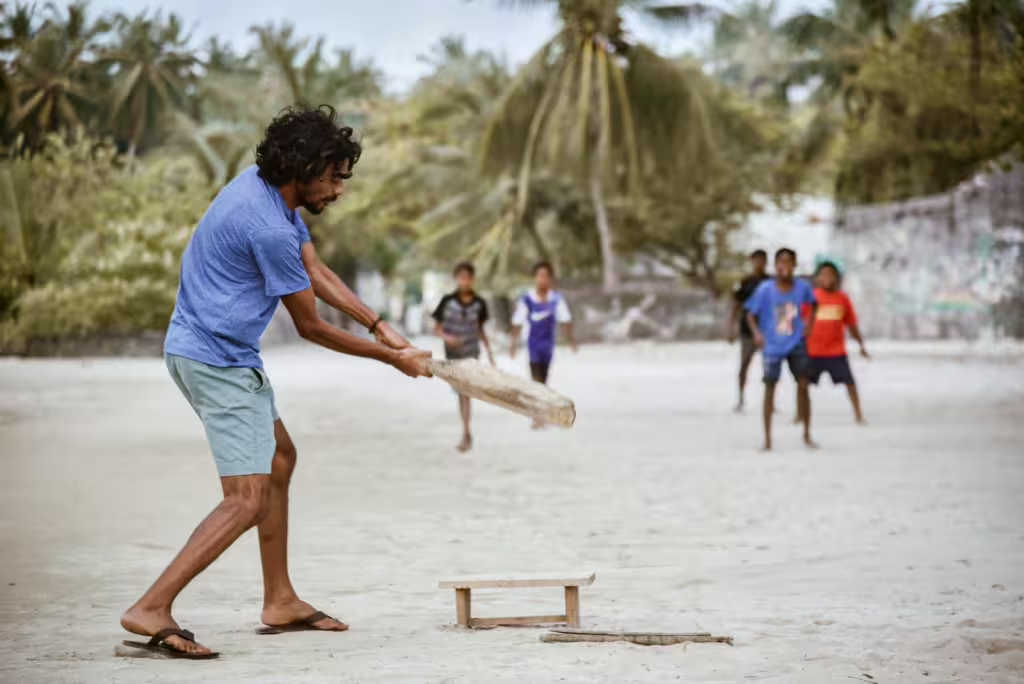Our American readers might find this an unusual article. After all, up until this point, we have mostly discussed youth sports that can be found in your own backyard. Nevertheless, the fact remains that, in other parts of the world, cricket is wildly popular. In fact, next to soccer, cricket stands tall as one of the most popular sports in the world. It is enjoyed by millions of people, kids, teens, and adults across several continents. From England to India, Australia to South Africa, cricket captivates fans and athletes, both.
Cricket’s blend of strategy, skill, and sportsmanship make it a great sport for young children to engage with. Thus, for parents looking to introduce their children to a wider range of sports, this global sport, makes for a great learning experience. In fact, understanding the basics of cricket can open the door to a new and exciting athletic experience for many young athletes.
In this article, we aim to introduce cricket to parents and kids in a comprehensive way. Whether you and your kids are completely new to the sport or just brushing up on the essentials, we’re here to help. Throughout the article we will explain the rules of cricket, the equipment needed, the roles of the players, and how kids can get started. At the same time, we will explore why cricket is a fantastic choice for developing coordination, focus, teamwork, and a lifelong love of physical activity.
What Is Cricket?
Those who think that cricket is similar to baseball are a little off-base, so to speak. All joking aside, this bat-and-ball team sport does share some similarities with America’s favorite pastime. Yet any similarities to baseball end with the bat and ball themselves, and even those are remarkably different. In addition, cricket has key differences in rules, scoring, and play style.
Cricket is played between two teams, typically of 11 players each. Athletes play on a large, oval-shaped field with a 22-yard-long rectangular pitch at the center. One team bats while the other bowls (pitches) and fields. While they are at bat, the batting team tries to score runs by hitting the ball and running between two sets of wooden stumps called wickets. Meanwhile, the bowling team tries to get the batters out and limit the number of runs scored by opposing players. Once the batting team has lost all their wickets or reached a set number of overs (a series of six balls bowled), the teams switch roles.
Games can either be quick, 20-minute versions (like street cricket or “backyard cricket”) or huge, multi-day matches at the professional level. This flexibility of sport makes it ideal for introducing to children as it can be done in a fun, low-pressure way.
Why Cricket Is Great for Kids
Like baseball, cricket isn’t just about hitting and throwing a ball around the pitch. As with most team sports, it offers a range of physical, mental, and social benefits that can positively impact a child’s development:
Coordination and Motor Skills: Batting, bowling, and fielding are great ways to improve hand-eye coordination, balance, and gross motor skills in young children.
Focus and Patience: Cricket teaches children that they need to wait their turn, stay alert, and think strategically if they want to succeed.
Teamwork and Communication: Players are taught that only by working together can they achieve success. Through play, they are taught all about fielding strategies, chasing balls, and supporting batters from all positions on the pitch.
Inclusivity and Adaptability: Cricket is highly versatile. It can be played casually or competitively, indoors or outdoors, and it can even be adjusted to suit different age levels and abilities. That’s right, there is even an adaptive version called Kwik cricket!
Cultural Awareness: Learning cricket helps children understand that different sports can be enjoyed in different places. Crocket is enjoyed globally and getting a chance to see what it’s all about can help build cross-cultural appreciation.
Whether your child dreams of being a star athlete or simply wants to try something new, cricket can be an accessible and rewarding experience; if one knows where to find a place to play.

Key Rules Explained for Parents
At first glance, and especially for those who are wholly unfamiliar with the sport, cricket can seem complicated. That said, once one understands the basics, it all comes together. Here’s a simplified breakdown for parents to teach their kids:
Overs and Balls: An “over” consists of six balls, otherwise known as pitches. Bowlers take turns delivering overs, pitching six balls to those at bat.
Runs: A run is scored when the batter hits the ball and runs to the opposite wicket. At the same time, the other batter does the same in the opposite direction.
Wickets and Outs: A batter can be declared “out” in several ways—bowled (ball hits the stumps), caught (fielder catches the ball before it hits the ground), or run out (fielder hits the stumps with the ball while batter is running).
Innings: During each period of the game, each team gets a turn to bat. This is what is known as an inning in cricket. Players try to score as many runs as possible within an inning before all batters are out. Depending on the game format, matches can have one or two innings per team and may be limited by overs. This latter situation arises in 20-over or 50-over formats.
Basic Cricket Equipment for Kids
Fortunately, even if there are no cricket leagues in your neck of the woods, you don’t need much to get started—just a few basic items will do:
Bat: Cricket bats are typically made of wood or lightweight composite material. Sizes vary based on age and height and are usually assigned to different age groups and styles of play.
Ball: Beginners will want to use a soft tennis ball or plastic ball to prevent injury, but higher levels of play use sturdier balls.
Wickets: Cricket wickets…there’s a fun combination of words, usually three vertical stumps with two small bails on top. Plastic or foam versions are more kid-friendly and readily available at most online retailers.
Protective Gear: Helmets, gloves, and pads are used in formal games but may not be needed for a bit of backyard fun.
Optional: Some games require boundary markers (cones), a scoreboard, and/or a flat surface for playing.
Most beginner programs provide or recommend gear, but many children start playing with whatever’s available at home or in the schoolyard.
How to Start Playing Cricket with Kids
Introducing cricket to kids can and should be fun, relaxed, and as age-appropriate as possible. Here are some tips for getting started:
Play Mini Games at Home: Parents can try simple activities like “bowling practice” using a soft ball and plastic stumps. The focus of this activity should be on throwing, catching, and hitting; you know, the basics.
Use Backyard or Park Spaces: Even if you only have a little recreational space, there are plenty of ways to play cricket at home. Try creating a mini pitch with cones or chalk lines. Plenty of folks have made due with much less. The trick is to let kids experiment and enjoy.
Watch Cricket Together: Watching cricket together is a great way to familiarize them with the sport. One good way to do this is to find highlights online or watch a live game. Do your best to familiarize yourself with the rules first though, that way you can explain what’s happening and cheer on the players together.
Join a Youth Program: Many local clubs offer beginner clinics or “intro to cricket” sessions for the uninitiated.
Encourage Creativity: Don’t be afraid to let your kids make up their own rules when they are first starting out. They will need to learn them eventually, of course, but for now they can use improvised equipment, or invent their own games and challenges related to cricket.
Remember, the goal at first isn’t perfection—it’s engagement, enjoyment, and exposure to the sport.
Age-Appropriate Formats for Kids
Cricket is adaptable for all ages and there are already some common formats designed for children at different stages of athletic development:
Kanga Cricket (Ages 5–8): This version features soft balls, smaller bats, and short games with simplified rules.
Junior Cricket (Ages 8–12): At this stage there is more structure, but the focus is still on participation and learning.
Youth Leagues (Ages 12+): Youth Leagues feature more formal games, incorporating standard rules, team strategy, and competition.
Inclusive and Adaptive Programs: Adaptive sports programs feature modified games for children with disabilities or special needs, with an emphasis on accessibility and fun.
Note that cricket’s innate flexibility makes it easier for children to progress at their own pace, with emphasis on growth and participation rather than just winning.
Helping Your Child Learn the Basics
Parents need not be cricket experts to help their kids get started in the sport. Here are a few simple ways that parents can support their child’s cricket learning experience:
Practice Basic Skills: Work on throwing, catching, batting, and running first and foremost. Short, playful sessions work best for getting these skills down-pat.
Use Visuals and Videos: Remember that kids often learn quickly by watching. Be on the lookout for beginner-friendly tutorials.
Encourage Questions: If your child is curious about rules or strategies, take the time to explore the answers to their questions together; you might learn something.
Celebrate Progress: Make sure that your focus is on fun, effort, and enthusiasm rather than technique.
Be Patient: As with any new sport, patience is a key element of finding progress. Skills like bowling accurately or hitting consistently take time, so be keep it cool as your child learns. The trick is to let them develop at their own pace.
Cricket Around the World: A Cultural Connection

Introducing your child to cricket is also a way of opening their eyes to the global nature of some sports. Cricket is deeply rooted in many cultures all over the planet:
India, Pakistan, Sri Lanka, and Bangladesh: Cricket is a passion and a national obsession in these places.
Australia and England: These two countries are home to major international teams and famous rivalries.
West Indies, South Africa, New Zealand: These areas are well-known for producing iconic players and dynamic teams.
Emerging Nations: Cricket is growing rapidly in the U.S., (yep, even here!) along with Canada, Afghanistan, and parts of Europe.
Watching matches from different countries or learning about famous players can foster a child’s innate curiosity and give them a global perspective.
Common Cricket Terms to Know
Getting down the cricket vernacular will work wonders for parents and new players alike. The cheat sheet below will likely prove most helpful in getting you and your child get started.
- Wicket: The set of stumps and bails. This term also refers to a batter being out.
- Bowler: The player who delivers the ball (pitches) to the batter is a bowler.
- Batter (formerly batsman): The player who hits the ball and runs to score is a batter.
- Over: Six legal balls bowled by one player constitute an over.
- Boundary: The edge of the field; hitting the ball past this boundary scores extra runs.
- Run Out: When a batter is caught outside the crease while running and the wicket is hit, it is referred to as a run out.
Note that these are just the bare-bones basics but learning the whole range of cricket vocabulary can make the game more engaging for you and your budding batters and bowlers!

Cultured Athlete Says…
As you can see, cricket might not be the first sport that comes to mind when introducing kids to physical fitness, but that doesn’t mean it’s any less intriguing than other sports! As a youth sport, cricket offers kids a rich, rewarding experience. Cricket’s emphasis on skill, strategy, and teamwork means are just as valuable as those found in soccer, football, baseball, and more. To many fans, all over the world, cricket is more than just a game—it’s a way to connect with other players and fans around the globe! With a bit of learning and a little practice, cricket could be your child’s ticket to building lifelong habits of health and happiness.
Discover more from CulturedAthlete
Subscribe to get the latest posts sent to your email.






